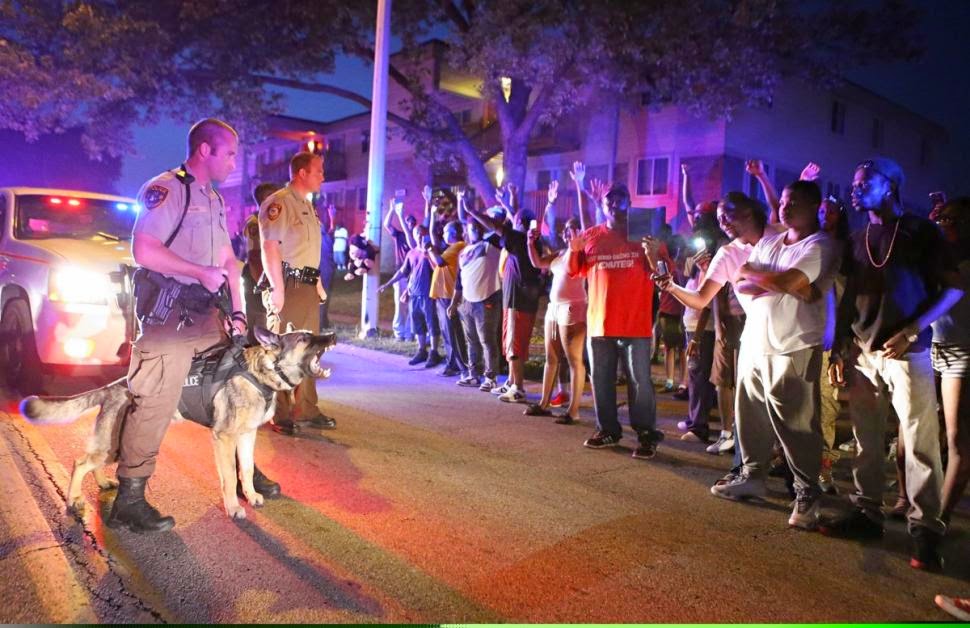Last week, an unarmed black teenager was fatally shot in Ferguson,
Missouri and left to lay in the street for four hours as a community
watched in horror. Tensions have mounted as police reports have varied
wildly from eye-witness accounts, and that anger was fueled further as
the police department refused to answer questions about his death. At
this point, the police chief has back-stepped his own statement of
facts, and is now unwilling to report that he knows anything definitive
about this boy’s death.
Protests
have erupted in Ferguson, and Ferguson police have responded in a way
that reveals the tension between the police and Ferguson’s black
residents. Video has been circulated depicting a police officer calling the crowd “f–king animals.”
When a few hundred people gathered in the middle of the day to speak
their concerns, they were met with a SWAT team, an armored car , and men
in camouflage pointing snipers at the crowd. The police have gone to
great measures to avoid any media coverage, as if they have something to
hide. Two prominent credentialed journalists who tried to report on the event were arrested.
In
a town where over 65% of the residents are black, Ferguson’s police
force of 53 officers includes only 3 black men. Residents report
long-standing issues with the police and racial tension. Mike Brown’s
death was a tragic catalyst for people who have long felt mistreated.
And yet, some people still question – how can this be about race?
Unfortunately, Mike Brown is but the latest in a series of disturbing events regarding police behavior against people of color. New York City’s “stop and frisk” policy
is but a minor example of the micro-aggressions black men face on a
daily basis. Many black people I know have their own stories about being
followed in a store or stopped for “driving while black”, or other
encounters in racial bias. But too often, this bias turns violent. Just this summer, an Arizona professor
was thrown to the ground by a police officer for “jaywalking” to avoid
street construction at the crosswalk . . . at the same time groups of
white people can be seen crossing behind the altercation in the dashcam
video. A few weeks ago, a grandmother was jaywalking and a highway
patrol officer took her to the ground and brutally beat her, punching her in the face repeatedly – which was caught on tape by a stunned stranger. Earlier this month another man was stopped by police for selling cigarettes and was put into a choke hold and killed.
In
perhaps the most stark example of racial bias this year, a young father
named John Crawford was shot and killed last week for holding a toy gun
inside Walmart . . . an airsoft gun that he planned to purchase.
As
I wrote out the stories above, I was tempted to look for information to
make these people more human . . . details to show that their lives had
value. But here is the thing:THEY ARE ALREADY HUMAN. Their lives
already have value. We shouldn’t need to know that they are going to
college or whether or not they smoked pot or had children or worked
full-time. One of the things that I found most profoundly disturbing in
the case of Trayvon Martin was the way people assassinated his character
as if some found defects were proof that his death was justified.
And
I believe this is the root of much of the racial bias. I believe that
we live in a country in which black people have been systematically
dehumanized . . . and I believe we are still living in that legacy.
(This reality is well documented in the book The Condemnation of Blackness.)
But you don’t have to believe my opinion. Nor do you have to believe
the anecdotal opinion of African Americans (though you should – because
they are the only people who can speak with authority on the experience
of black Americans.) The bias inherent in law enforcement has been well
documented with empirical research as well. In repeated psychological tests conducted by the psychology department at the University of Colorado, researchers illustrated the implicit suspicions people hold against people of color:
Participants
shoot an armed target more quickly and more often when that target is
Black, rather than White. However, participants decide not to shoot an
unarmed target more quickly and more often when the target is White,
rather than Black. In essence, participants seem to process
stereotype-consistent targets (armed Blacks and unarmed Whites) more
easily than counterstereotypic targets (unarmed Blacks and armed
Whites).
We
have a problem with racial bias and law enforcement in this country. I
want to be clear – I don’t think that all cops are racist . . . or bad
people. My sister was on the police force for a long time. I respect
what they do immensely. But I believe that naturally, police officers
reflect the racial bias that is present in our society at large. And
unfortunately, in their position of authority, it can have deadly
consequences.
We will never solve this by pretending
that there aren’t racial elements to these events. Nor will we solve it
by pretending that we’re “over race.” The only way we can address this
is by acknowledging the racial bias in our society and working to solve
it, and by demanding accountability from law enforcement when it comes
to the treatment of black Americans. And we can start by watching what
is happening in Ferguson right now, and speaking up about it. Their
residents have a right to be angry, and they have a right to answers,
and they have a right to be heard.


